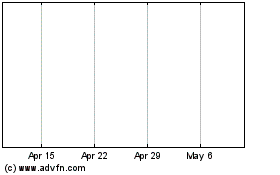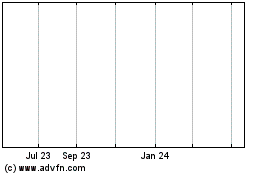The Economy: Coming in for Landing in 2007
December 04 2006 - 3:34PM
PR Newswire (US)
Economic Outlook and Market Strategy from A.G. Edwards ST. LOUIS,
Dec. 4 /PRNewswire-FirstCall/ -- Following the dramatic increases
in short-term interest rates by the Federal Reserve over the past
two years and given the current downturn in the domestic housing
market, there's not much question as to whether the U.S. economy is
slowing down. The big debate, of course, is whether the country
will experience a "hard" landing -- in other words, a recession --
or see the economy merely slow to a modest growth rate and then
take off again after a more forgiving "soft" landing. To help
investors get a better handle on the hard versus soft landing
debate, financial services firm A.G. Edwards (NYSE:AGE) has just
released the 2007 outlook report from its Investment Strategy
Committee. With insight from a wide range of sources, the report
combines viewpoints from the firm's market strategists, economists,
analysts and portfolio managers to examine the debate and identify
the risks and opportunities the committee sees in the year ahead.
Chief Economist Gary Thayer notes that over the past five years,
the economy has oscillated between extremes -- in recession or
struggling out of it from 2001 to 2003 but then showing strength
and expanding at an above- average rate from 2004 through the early
part of this year. The Fed has drained excess liquidity from the
economy with its lengthy cycle of consecutive rate hikes, and
Thayer thinks the most likely scenario at this point is a soft
landing between these two extremes. "The Fed does not want the
economy to swing between boom and bust," Thayer says, "but that
does not mean it could not happen." In addition to the gradual Fed
rate increases, which gave borrowers time to adjust to tighter
credit conditions, Thayer points out several other factors that may
be indicative of things to come. A sharp drop in energy prices in
the second half of this year, a halt in the Fed rate hikes once the
housing market weakness became pronounced and continued growth in
corporate profits have all helped offset other problems and seem to
be setting the stage for a soft landing. Turning attention to the
stock market, Chief Market Strategist Al Goldman enumerates some of
the pressing issues that could possibly turn into stumbling blocks
for the soft landing scenario. He says the areas of greatest
concern are geopolitical, as Iraq, Iran and North Korea will likely
remain very serious problems for our country going forward. But
Goldman takes heart in the trends that are currently in place in
the economy and says recent history bodes well for the near-term
market outlook. "Economic activity has slowed primarily because of
the recession in the building industry," Goldman says. "However,
the economic trends in place indicate a slowdown rather than a
meltdown, and thus, we look for a soft landing in 2007." Goldman
notes that the rising market is now 49 months old, compared with
the average duration of 25 months for previous bull markets. But he
also points out that the current market's advance has been more
labored than most, and a couple of years of lackluster growth in
the middle have helped increase its longevity. Goldman is looking
for an increase in S&P 500 earnings on the order of about seven
percent over 2006 earnings, which would predict a target for the
S&P of approximately 1472 in late 2007. To give investors a
clearer picture of where they should focus their investment
dollars, Chief Equity Strategist Stuart Freeman offers several
sector picks for the new year. "Based on our expectations for a
slower growth economic environment during the first half of 2007,
we continue to suggest investors overweight the defensive health
care and consumer staples sectors," Freeman says. "However, because
more cyclical stocks have already retrenched during the course of
the year, our industry group rankings include a larger mix of more
cyclical stocks than they did six months ago." Some examples of
Freeman's most favored individual industry groups include: energy
companies (except the major integrated international names),
agricultural products, construction & engineering, health care
distributors, building products, water utilities, steel, managed
health care, household appliances, and reinsurance companies. For
more information about the firm's outlook in these and other areas
-- including fixed-income research, currency and debt analysis,
geopolitical events, equity and fixed-income portfolio strategies,
and securities research -- copies of the A.G. Edwards 2007
Investment Guide are available on the firm's Web site,
agedwards.com, or by calling one of the firm's 700 branch offices
across the country. About A.G. Edwards Drawn to the firm's
client-first philosophy, individuals and businesses have turned to
A.G. Edwards for sound advice and access to a wide array of
investment products and services that can help them meet their
financial goals and objectives. Founded in 1887, A.G. Edwards and
its affiliates employ more than 6,500 financial consultants in more
than 700 offices nationwide and two European locations in London
and Geneva. More information can be found on agedwards.com. How we
do business A.G. Edwards generally acts as a broker-dealer but may
act as an investment advisor on designated accounts, and the firm's
obligations will vary with the role it plays. When working with
clients, the firm generally acts as a broker-dealer unless
specifically indicated in writing. To better understand the
differences between brokerage and advisory services, please consult
Important Information About Your Relationship With A.G. Edwards on
agedwards.com/disclosures. DATASOURCE: A.G. Edwards CONTACT: Byron
Goodrich of A.G. Edwards, +1-314-955-3235, or Web site:
http://www.agedwards.com/
Copyright
A G Edwards (NYSE:AGE)
Historical Stock Chart
From Jun 2024 to Jul 2024

A G Edwards (NYSE:AGE)
Historical Stock Chart
From Jul 2023 to Jul 2024
